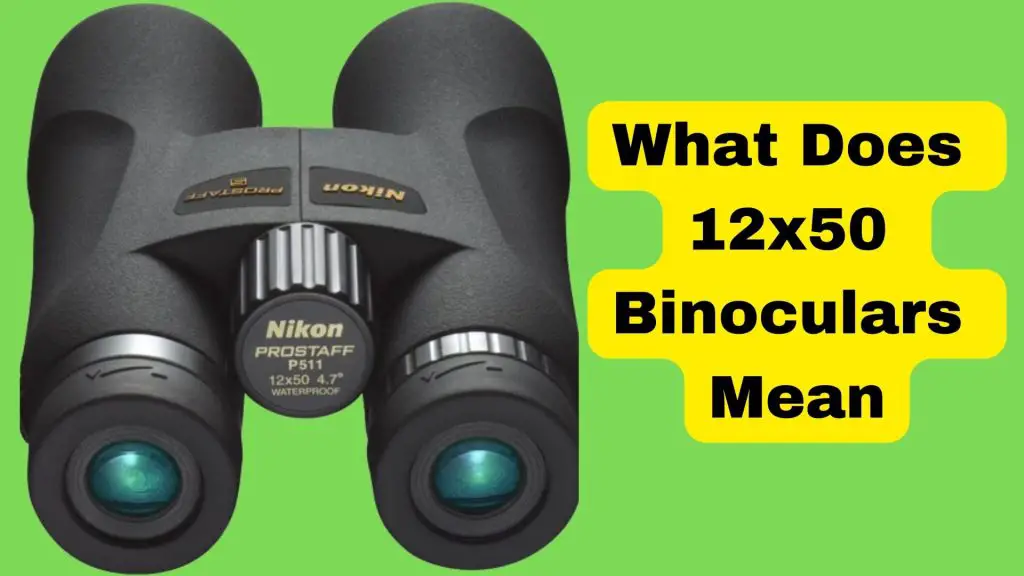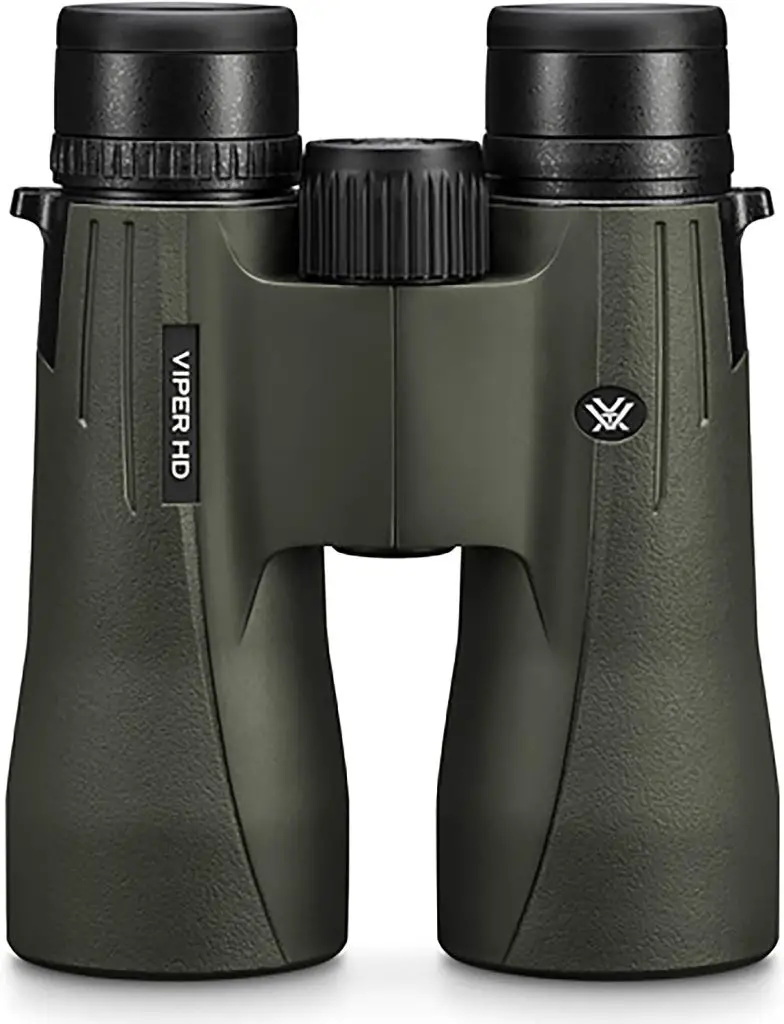What Does 12×50 Mean in Binoculars?

Binoculars come in various configurations, each represented by a series of numbers, such as 8×42, 10×50, or 12×50.
These numbers hold crucial information about the binoculars’ capabilities and performance.
In this article, we will reveal everything about one of the most common specifications, “12×50,” and see in what activities these binoculars will be best suited.
What Does 12×50 Mean?
Magnification power (12x)
Definition of Magnification:
Magnification refers to the factor by which the binoculars can enlarge an object when viewed through them.
In the case of “12×50” binoculars, the number 12 indicates that the binoculars magnify an object twelve times its actual size.
This means that an object 100 meters away will appear as if it were just 8.33 meters away when viewed through these binoculars.
How to Interpret the Magnification Number:
A higher magnification number, like 12x, provides a closer and more detailed view of distant objects.
It is particularly useful for observing wildlife, birds, or distant landmarks. However, higher magnification also narrows the field of view, making it challenging to track fast-moving subjects or observe a wide area at once.
Advantages and Limitations of High Magnification:
Advantages:
High magnification allows you to observe intricate details and brings you closer to your subject without physically getting too close.
It’s ideal for activities like birdwatching or stargazing, where a closer view is desired.
Limitations:
The main limitation of high magnification is image stability.
Handheld binoculars with 12x magnification might be more prone to image shake due to hand movements.
Additionally, the narrower field of view can make it difficult to locate and track fast-moving objects.
For activities that require a wider perspective, such as sports events or scenic views, lower magnification binoculars might be more suitable.

Related Read: Which Vortex 12×50 Binoculars Should I Buy?
Objective Lens Diameter (50)
Definition of Objective Lens Diameter:
The objective lens diameter is represented by the second number in the binocular specification (12x50). It indicates the size of the front lenses in millimeters.
In this case, the binoculars have an objective lens diameter of 50mm.
The Role of Objective Lens Size in Binocular Performance:
The objective lens plays a crucial role in determining the light-gathering capability of the binoculars.
A larger objective lens allows more light to enter the binoculars, resulting in brighter and clearer images, especially in low-light conditions.
This is particularly advantageous during dawn, dusk, or when observing celestial objects in the night sky.
Trade-offs of Larger Objective Lenses:
Advantages:
Binoculars with larger objective lenses excel in low-light conditions, making them perfect for stargazing and wildlife observation during the early morning or late evening.
They provide enhanced image brightness and better contrast, resulting in more satisfying views.
Limitations:
While larger objective lenses offer better low-light performance, they also make the binoculars heavier and bulkier.
This can impact portability, especially during extended outdoor activities. Additionally, larger objective lenses might require a tripod for more stable viewing.
Field of View (FOV)
Field of View refers to the width of the area that can be seen through the binoculars at a specific distance.
It is typically measured in degrees, indicating the span of the scene you can observe from left to right.
A wider FOV allows you to see a larger portion of the landscape, while a narrower FOV restricts your viewing range to a smaller area.
Relationship between Magnification and FOV
As magnification increases, the FOV narrows, and vice versa.
This means that binoculars with higher magnification, such as 12×50, will have a narrower FOV compared to binoculars with lower magnification, like 10×42 or 10×50.
12×50 binoculars offer powerful magnification and are great for observing distant objects, but they come with a narrower FOV.
On the other hand, 10×42 and 10×50 binoculars provide a more balanced view, with a wider FOV, making them versatile for various activities, including birdwatching, nature observation, and sports events.
Exit Pupil and Twilight Factor in 12×50, 10×42, and 10×50 Binoculars
Exit Pupil
Exit Pupil refers to the small, circular beam of light that emerges from the eyepiece of binoculars and enters your eyes.
It is measured in millimeters and plays a crucial role in determining the brightness of the image you observe.
Exit Pupil Calculation:
- 12×50: Exit Pupil = Objective Lens Diameter ÷ Magnification = 50 ÷ 12 = 4.17 mm
- 10×42: Exit Pupil = 42 ÷ 10 = 4.20 mm
- 10×50: Exit Pupil = 50 ÷ 10 = 5.00 mm
Implications of Exit Pupil on Brightness of The Image
- 12×50: With an exit pupil of 4.17 mm, 12×50 binoculars offer decent performance, suitable for stargazing and wildlife observation during dawn and dusk.
- 10×42: Similar to 12×50 binoculars, 10×42 models also provide an exit pupil of 4.20 mm, resulting in good low-light performance and brighter images in challenging lighting conditions.
- 10×50: With an exit pupil of 5.00 mm, 10×50 binoculars excel in low-light situations, providing brighter and clearer images, especially during twilight hours or in dimly lit environments.
Twilight Factor:
Explanation of Twilight Factor
Twilight Factor is a metric that determines binoculars’ ability to gather light and deliver a bright image in low-light conditions, such as at dawn or dusk.
It is calculated using the square root of the product of the objective lens diameter and the magnification.
Twilight Factor Calculation:
- 12×50: Twilight Factor = √(50 x 12) ≈ 18.33
- 10×42: Twilight Factor = √(42 x 10) ≈ 20.49
- 10×50: Twilight Factor = √(50 x 10) = 22.36
Implications of Twilight Factor on Low-Light Performance:
- 12×50: With a Twilight Factor of approximately 18.33, 12×50 binoculars offer decent low-light performance.
- 10×42: With a Twilight Factor of around 20.49, 10×42 binoculars perform slightly better in low-light conditions compared to 12×50.
- 10×50: With a Twilight Factor of 22.36, 10×50 binoculars outperform both 12×50 and 10×42 models in low-light scenarios, delivering brighter and clearer images, especially during challenging lighting conditions.
I will presume that the binoculars are of equal quality or from the same manufacturer.
12×50 binoculars offer decent low-light performance, but 10×50 models with their larger exit pupil and higher Twilight Factor provide brighter and clearer images in dim lighting.
On the other hand, 10×42 binoculars strike a balance between portability and low-light performance.
Also Read:10×42 Vs 12×50 Binoculars
Popular Uses of 12×50 Binoculars
Mountain Hunting and Observation:
When venturing into the wild for mountain hunting, the 12×50 binoculars prove to be invaluable.
Their larger 50mm objective lens captures more light, providing a brighter and clearer view of the rugged terrain.
The 12x magnification allows you to get up close to your target and spot game from a distance.
Whether you’re tracking elusive game or scanning the vast mountainous landscapes, these binoculars offer a powerful tool for your outdoor pursuits.
Spotting Scope Substitute:
In situations where you and your hunting partner share one spotting scope, the 12×50 binoculars step in as an excellent substitute.
Their higher power bridges the gap between standard binoculars and the spotting scope’s magnification.
This enables both hunters to actively contribute to observation without the need for an extra spotting scope.
You can swiftly scan the terrain, making informed decisions without compromising on optical quality.
Stellar Observations:
12×50 binoculars are a great choice for amateur astronomers.
They offer a higher magnification that allows you to observe celestial bodies in greater detail.
From the moon’s craters to distant planets like Jupiter and Saturn, these binoculars can bring the wonders of the night sky to life.
Constellation Exploration:
With their excellent light-gathering capabilities, 12×50 binoculars reveal numerous stars within constellations, helping you navigate the night sky with ease.
You can spot star clusters and even some deep-sky objects, like the Pleiades or the Andromeda Galaxy.
Birdwatching:
12×50 binoculars are a favorite among birdwatchers.
Their higher magnification lets you observe birds in intricate detail, from their distinctive plumage to their behavior. They are especially useful for spotting distant or elusive bird species.
Wildlife Safari In The Midwest
For wildlife observation in the Midwest, where you frequently move and stop along the way, the 12×50 binoculars are an ideal choice.
The extra power provided by the 12x magnification allows you to quickly survey the landscape without the need for a tripod and spotting scope setup.
This is particularly advantageous when seeking elusive creatures like mule deer and pronghorns. With the 12x50s, you can swiftly spot and appreciate the abundant wildlife of the region.
Sports Action:
Whether you’re at a stadium or an open field, 12×50 binoculars bring sports events to life.
You can follow the movements of athletes and enjoy a more immersive experience, even from the nosebleed seats.
Air Shows:
During air shows and aviation events, 12×50 binoculars help you focus on high-flying planes, aerobatic maneuvers, and other thrilling aerial displays.
My Favourite 12×50 Binoculars
I would love to share one of my favourite 12×50 binoculars i.e the Vortex Razor UHD binoculars
The 12×50 binoculars, exemplified by the Razor UHDs, boast superior glass quality, delivering crystal-clear and sharp images.
This high-quality optics enable precise wildlife observation and critical hunting tasks.
Whether you are assessing game behavior or identifying specific features, the 12×50 binoculars offer a premium viewing experience, enhancing your outdoor adventures.
I will recommend more 12×50’s in all budget ranges as I will test them and update them in the upcoming articles.
An Interesting Video about 12×50 Binoculars
Conclusion
Understanding the numbers behind binocular specifications, such as 12×50, is essential for choosing the right binoculars that suit your needs.
A 12x magnification allows for closer views, but it comes with trade-offs in terms of image stability and field of view.
On the other hand, a 50mm objective lens diameter enhances low-light performance, but it might result in bulkier binoculars.
Consider your purpose when selecting binoculars to ensure an enjoyable and immersive viewing experience.
